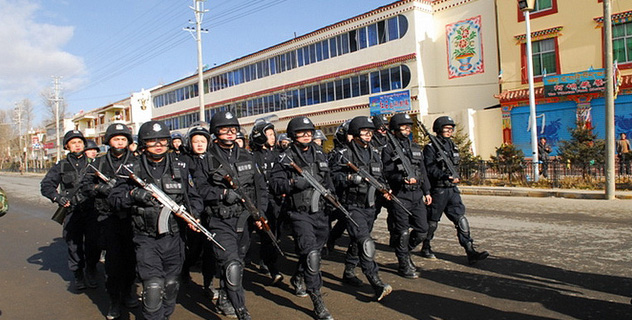 Tibetans Turn to Alternative Protest as Self-Immolations Prove Futile
Tibetans Turn to Alternative Protest as Self-Immolations Prove Futile
Last year, Norbu Jorden ran away to New Delhi to set himself on fire. Driven by accounts of other self-immolations by Tibetans — there have been 112 deaths since 2009 — the 20-year-old student concluded that this was the only way he could contribute to Tibet’s struggle for freedom from China. Jorden did not succeed: before he could engulf himself in flames, police in the capital intervened and eventually sent him back to Dharamsala in northern India, the sanctuary for Tibetans fleeing Beijing’s hard-line rule of their homeland. Now Jorden is expressing his dissent differently. On a Wednesday in late March, he was one of hundreds of young Tibetans kitted out in traditional robes and singing boisterously at a school in Dharamsala. The event was part of a weekly peaceful protest called Lhakar — “White Wednesday” in Tibetan — which takes place in the city where the Dalai Lama set up his exiled administration in 1959. “I wanted to do something to be a part of our freedom struggle, and [self-immolation] was the only way I knew,” says Jorden. “When I came back to school and was introduced to Lhakar, I realized this was a better way.”
In recent years, young Tibetans-in-exile have found in Lhakar an alternative to the gruesome and desperate act of self-immolation. Lhakar is a movement inspired by Mahatma Gandhi’s principles of nonviolence and noncooperation to rid India of British colonialism. In the 1980s, when Lhasa erupted in violence against Chinese rule and the authorities subsequently clamped down on the region, many in China’s Tibetan areas continued to secretly visit temples on Wednesdays, the day the Dalai Lama is believed to have been born, to pray for him. But in 2008, when the Chinese authorities started cracking down on religious activities associated with the Dalai Lama, Tibetans devised the subtler Lhakar. For the past five years, Tibetans, both in China’s Tibetan regions and in exile, have reasserted their cultural identity through thinking, talking, eating and buying Tibetan once a week.
On Wednesdays at Jorden’s school in Dharamsala, children only speak in Tibetan, unmixed with Mandarin, Hindi or English. They listen to Tibetan music, not Bollywood or Western. Lunch comprises traditional Tibetan food like bhaktsa, a dessert, with pasta, cheese soup and tsamba, or roasted barley flour, a staple dish consumed with butter tea all over China’s Tibetan regions. “For any movement to succeed … it should be one where common people can join in, understand and relate,” says Dorjee Tseten, regional director of the India chapter of Students for a Free Tibet.
Lhakar became a political force in 2011 when Lobsang Sangay, the current Prime Minister of the Tibetan government-in-exile, exhorted Tibetans worldwide to embrace this form of protest. “I kept hearing about a Lhakar drive going on in some parts of Tibet,” Sangay tells TIME. “I felt, as a leader, I had to rally around ideas or events that address the core of the Tibetan struggle and can mobilize people.” Since then, the weekly rite has grown exponentially: leaders say participation in India, where more than 110,000 Tibetans live, has doubled in the past 18 months.
Lhakar is unlikely to sway Beijing to ease control over China’s Tibetan regions, and has not led to the end of self-immolations. In 2011, 13 Tibetans set themselves on fire; last year, that number rose to 70. As people around the world have begun to associate Tibet’s struggle with flames, followers of Lhakar hope that their movement will offer an alternative — and harmless — way for young Tibetans to express their anger. “Self-immolation will reduce our population further, and until now, it has not achieved any significant reaction from the world community,” says Rigchen Wangwal, an 18-year-old student at Jorden’s school. “[Self-immolations] have not been an effective protest. Lhakar will be. There is no way to put a stop to it.”
The Chinese are trying to. Last fall, authorities in Tibet’s Shershul district arrested a Tibetan woman for wearing a chuba, a robelike garment often worn over an ornate Tibetan shirt, on a Wednesday. In the past year, hundreds of people in Tibet have been detained for taking part in language-preservation groups, and others for promoting vegetarianism, which older Tibetans believe will prolong the Dalai Lama’s life if they practice it. Adherents of Lhakar say the Chinese state’s efforts to stamp out Tibetan culture are futile. “Lhakar is very subtle, and yet very strong,” says Sangay. “By following Lhakar, you are not violating any Chinese laws but at the same time you are eliminating or diluting the element of fear.” Perhaps that’s what scares Beijing most. http://tibet.net/2013/04/17/time-tibetans-turn-to-alternative-protest-as-self-immolations-prove-futile/